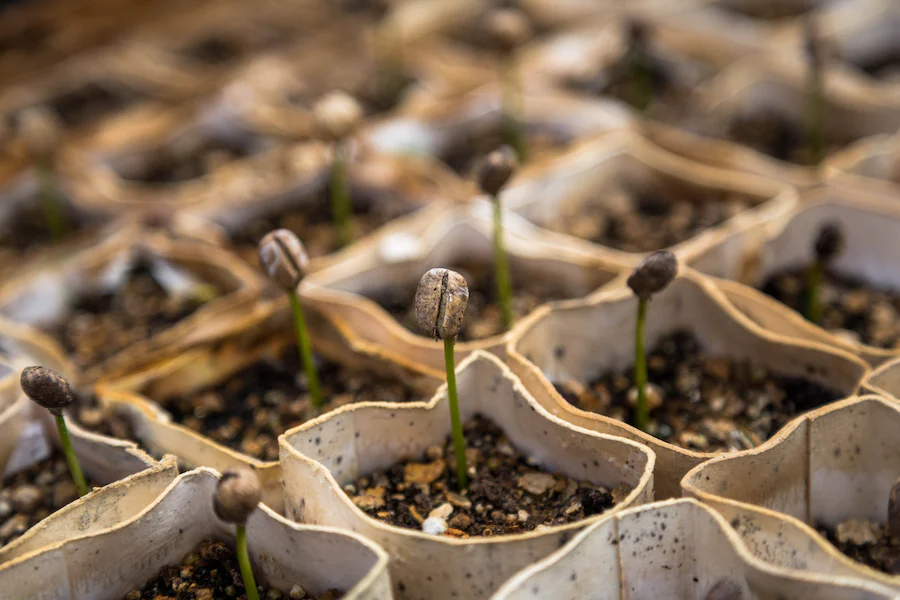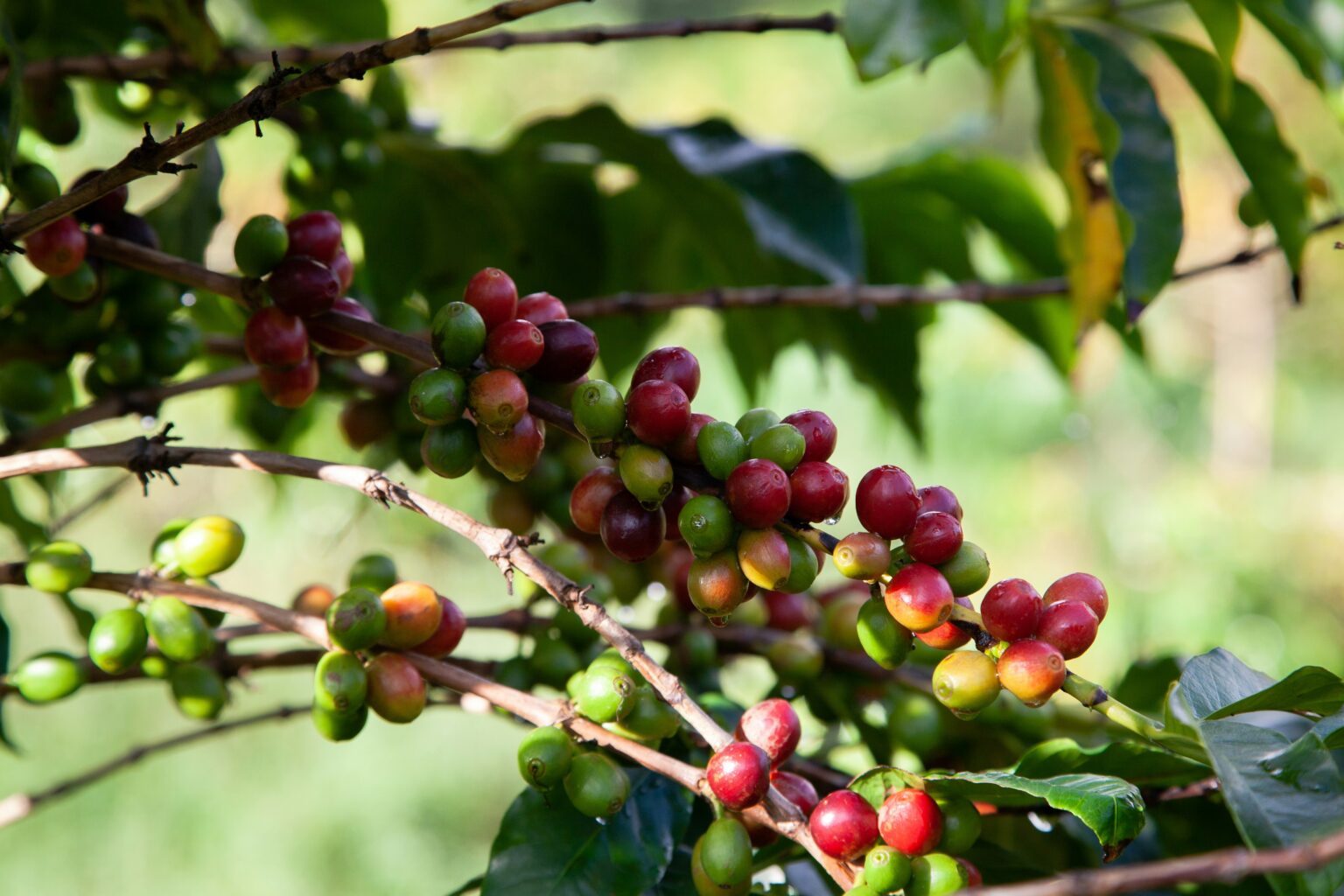Coffee
Caffè Crema, Espresso, Cappuccino
General information
According to legend, a goatherd discovered coffee in the 9th century when he noticed that his goats no longer seemed to get tired after they had nibbled on the red coffee cherries. He then tried the strange fruit himself and quickly noticed its stimulating effect. We now know that coffee (Coffea) is a plant genus with 124 known species. We are mostly only familiar with Arabica coffee (Coffea arabica) and Robusta coffee (Coffea canephora), which we usually consume in our everyday lives in the form of a popular hot drink. The coffee plant consists of a coffee cherry, pulp, which tastes slightly sweet like honey, and two coffee beans, which are enclosed in a silver skin and a “parchment husk”.

Growing regions
The coffee plant is a very sensitive crop and therefore requires certain climatic conditions in order to achieve an optimal harvest. These areas are located in the so-called “coffee belt” and are ideal for cultivation, due to their humid and tropical climate where this plant feels most at home. The coffee belt encompasses Central and South America and large parts of Africa; in some regions in Asia the conditions for the coffee plant are also ideal. The largest coffee-growing regions are in Ethiopia, Vietnam and Colombia, but Brazil is the undisputed leader in terms of coffee production. The map on the left shows the countries with the largest share of the global coffee market, although coffee is grown in almost all countries in the coffee belt.
Cultivation and harvest
The coffee plant is a very sensitive crop that needs a balanced climate, enough rain and plenty of shade. In regions with constant temperatures, several harvests per year are therefore possible, while in areas with large temperature differences, the fruit can only be harvested once. Regarding harvesting methods, a distinction is made between “picking” and “stripping”. While in the first method only the really ripe cherries are picked by hand, in the second method all the coffee cherries are picked at the same time, which can result in a loss of quality. However, the latter method is the one most commonly used for the conventional market. There are also two different methods for processing the harvested fruit: the dry method and the wet method. In the dry method, the cherries are dried in the sun for three to four weeks, constantly turned, and then peeled using special machines, from which the green coffee is produced. In the wet process, most of the pulp is mechanically removed in fermentation tanks and the fruit is softened, which separates the silver skin from the bean and produces green coffee as the end result.


Ordinary products?
The classic ones: espresso (the little pick-me-up), cappuccino (magic formula 1/3 – 1/3 – 1/3), latte (more milk, less coffee), flat white (two espressos and less milky) or simply filtered.
The creatives ones: Recycled coffee, coffee beans and other parts of the plant can be used to make upper material for shoes, for example. Recycled coffee grounds can also be turned into coffee moulds and to-go cups, tasty oyster mushrooms can be grown or sustainable biofuel can be produced.
Certification
Certification is a voluntary, market-driven approach. They confirm that certain criteria with regard to the cultivation or production of products have been met. This offers consumers the opportunity to consciously choose to buy certified coffee from sustainable cultivation.
Coffee labels indicate coffee that meets ecological and social standards. Certified coffee is already widespread on the international market, with the following labels being the most widely known: Fairtrade, Rainforest Alliance, 4C Association, organic certifications for coffee from organic farming. Sustainable coffee cultivation focuses on protecting the environment and improving living conditions in the producing countries.
Bio-Zertifizierung
Das verpflichtende EU-Bio Logo kennzeichnet seit dem 1. Juli 2010 alle vorverpackten Bio-Lebensmittel aus der EU, welche die strengen Normen der EU-Rechtsvorschriften für den ökologischen Landbau erfüllen. Mit dem Bio-Siegel können darüber hinaus Produkte und Lebensmittel gekennzeichnet werden, die nach den EU-Rechtsvorschriften des ökologischen Landbaus produziert und kontrolliert wurden. Kaffeeprodukte mit Bio-Siegel müssen den Vorgaben der EG-Öko-Verordnung entsprechen. Hier wird der Kaffee in Mischkulturen angebaut, der Einsatz von Pestiziden und Kunstdünger ist verboten und die Bohnen werden von Hand geerntet.
Anbauverbände
Neben der Bio-Zertifizierung nach gesetzlichen Regelungen kann eine Zertifizierung nach privatrechtlichen Standards angestrebt werden. Dies geschieht im Rahmen verschiedener Öko-Anbauverbände. Beispiele hierfür sind Bioland, Naturland, Demeter oder Biokreis. Die Richtlinien der meisten ökologischen Anbauverbände gehen in ihren Anforderungen an Produktion und Verarbeitung über die Vorschriften der EU-Öko-Verordnung hinaus. So stellt Naturland für den Anbau von Kaffee kulturspezifische Anforderungen auf. Ökologischer Kaffeeanbau erfolgt hier in standortangepassten Agroforstsystemen unter Schattenbäumen.

Sustainability through agroforestry
Although the highest yields can be achieved with sun coffee in monocultures, these are associated with many ecological disadvantages: a decline in biodiversity, soil contamination or forest degradation. One way of making coffee cultivation more sustainable could be agroforestry. The term is made up of “agriculture” and “forestry” and already indicates that these are land use systems that combine trees and the cultivation of crops. Possible combinations include trees and arable crops, trees with livestock or trees with other tree or shrub crops such as coffee. A distinction can be made between two agroforestry systems: In the case of degradation through agroforestry systems, forests are thinned out and original plants are replaced with shade-tolerant crops such as coffee. When rehabilitation occurs, however, open farmland is increased and land areas can see an increase in biodiversity through the introduction of agroforestry plants. Many aspects need to be considered for a successful coffee agroforestry system: The combination of plants, the planting time of the shade trees, the distance between the plants and the optimum temperature of the different coffee varieties.
